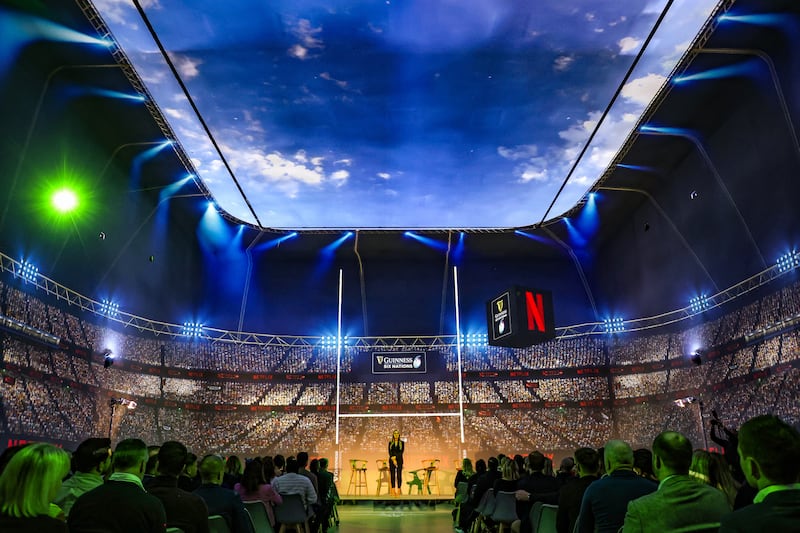There’s a very sweet moment in the final round-up scene of Full Contact, otherwise known as the Netflix Six Nations rugby series that comes out today. Johnny Sexton is walking across a training pitch with his boy Luca, who tells his dad that they should do their secret handshake. Sexton whispers, “We can’t show them our secret handshake. They’re not ready for it.” And the pair of them walk on past the Netflix camera crew and into Sexton’s retirement.
That’s nice. That’s wholesome, nice good stuff. Unforced, warm and real. No notes, as they say. The eight Full Contact episodes are all around 45 minutes long and if you had three or four of those moments in each one, you’d come away delighted with how you’d filled your time. But ultimately, it’s memorable because of how rare it is.
Having watched the whole series over the past few days, this reviewer is pleased to inform you that Full Contact is okay. Don’t let anyone tell you it’s terrible. Equally, don’t let anyone pretend it’s amazing. It’s grand. It’s right in that twilight zone where there are just enough interesting bits to keep you watching and yet all too few to keep you satisfied.
If you’ve seen any of the other Netflix sports stuff, you know the drill. The F1 one, the golf one, the tennis one – they all follow more or less the same template. Pick out some people, follow them a bit outside their sport, film them in settings where they’re normal for a bit rather than the sportspeople we see on the telly. Sprinkle in some game footage and away you go.
As a viewing experience, the results have been pretty up and down. Drive To Survive, the original of the species, was lightning in a bottle. It helped that it was first. It helped that it had that F1 sheen, that monied glaze, that greasy veneer of glamour against which to contrast the day-to-day lives of the drivers. It helped too that you could throw some megalomaniac team owners into the mix and watch them in real time as they lost their shit.
Full Swing – the golf one – was far more uneven. Partly this was down to who they followed. Jordan Spieth and Justin Thomas were dull as dishwater. Tony Finau was terribly nice, Scottie Scheffler was almost pathologically uninteresting. But Brooks Koepka, Joel Dahman and even, given the palace intrigue of the time, Rory McIlroy were all worth your time.
The big drawback for Full Contact is that regardless of how interesting or open the rugby players are in real life, the cameras that followed them through the Six Nations found them all in team mode. So even if Finn Russell can be a notoriously free spirit – and the cracks in his relationship with Gregor Townsend are definitely not glossed over here – the version you get of him in Full Contact is Russell on his best behaviour. You don’t come away thinking of him any differently than you did before.
That is replicated throughout. A lot of the interviews are done on organised media days in camp. No matter how invested the subjects are in the project, the reality is they’re still at work. They’re in their national tracksuit, they have a defined amount of time before they have to be at the next team meeting, they’re answering questions on autopilot.
Even when the Netflix crew are out and about with the players or coaches, there’s precious little spontaneity. Ellis Genge goes on a drive around the area he grew up, Andrew Porter walks his dog, Blair Kinghorn lies on the couch as his partner answers her emails while walking on a treadmill in their living room. There’s a façade of access. You go behind the scenes but it’s not always clear what exactly you are doing there.

Some of it is wilfully exclusionary to the outside world – the World Cup is never mentioned, for instance. Kieran Crowley’s last words to the camera crew inform them that he’s out of a job now, the implication being that Italy gave him the bum’s rush as soon as the Six Nations ended with them bottom of the table. But of course he didn’t – he was the Italy coach at the World Cup six months later.
The answer to such nitpicks as these is always the same – Netflix aren’t aiming Full Contact at just rugby fans. They want this to pop up on the Top Picks list for Eddie in Ohio and Astrid in Malmo and Luis in Bogota when it drops this week. They know that you know that the Wales camp was in crisis during the Six Nations and that they were prepared to go on strike for the England game. But delving too deep into the reasons for all that would risk losing the casual viewer in the weeds of it all. So they don’t.
What they deliver instead is a glossy, beautifully-packaged account of the 2023 Six Nations. It’s not unlike the American Football series Hard Knocks, albeit none of the players are mic’d-up on the field of play or in training. And there are talking-head pundits giving context rather than a voice-of-God narrator.
And there are definitely pockets of insights worth keeping an eye out for here and there – France’s mindfulness meeting the week after losing to Ireland is interesting, for instance. As is Scotland’s way of announcing their starting 15 – Stuart Hogg seems not to have been tipped off in advance on whether he’d be starting against Ireland for his 100th cap. Instead, the one moment of dramatic tension in the whole series is the team being named from 1-to-15 in a kind of silent movie projected up on the screen in front of the whole squad with the camera bouncing between Hogg and Kinghorn throughout. Harsh.
All in all, you’ll probably watch it. And you should. Just don’t expect to come away with a whole new perspective on last year’s Grand Slam because of it. That’s not what it’s for.


















